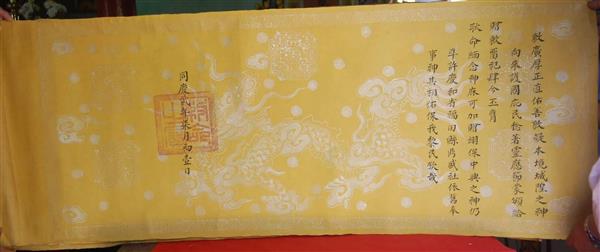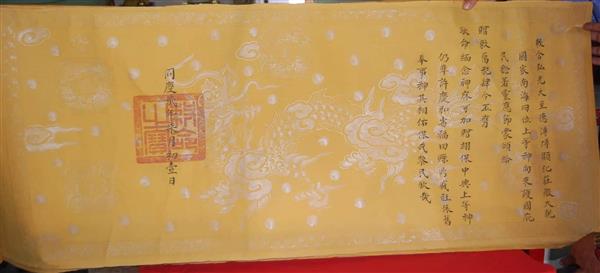Description
Dinh Danh Thanh is located on a mound of land in Danh Thanh village, Dien Loc commune, Dien Khanh district, Khanh Hoa province (formerly belonging to Truong Loc Trung commune, canton Trung, Phuoc Dien district, Dien Khanh district), located far from Nha Trang city. about 21km to the west.
Through studying historical documents at the communal house, it is said that: The communal house was built before the 5th year of Tu Duc (1852)[1], because the ancestors came here to open the village and set up a hamlet to worship Ban Canh Thanh. Hoang, Dai Can Quoc Nam Hai, Thien Y Thanh Mau, Tien Hien, Hau Hien…
Over time, together with the harsh weather, the communal house deteriorated, people have repaired and embellished the communal house many times, most recently in 1957, 1998.
Just like many other communal houses in the region (My Loc communal house, Binh Khanh communal house, Dai Huu communal house...), Dinh Danh Thanh consists of a feng shui plan in front, a large brick yard in the back and a Son Lam temple, the main work is the sacrifice. , the main hall, the left and right sides are the East house and Tien Hien Temple. All of the above work items are located in an area of 710m2, the pavilion faces Southeast.
The main worshiping work of the communal house is arranged in the style of Nhi (二) Nhi, including the sacrifice and the main hall. The sacrifice is the place to sacrifice offerings to the gods, designed with three equal compartments, an area of 20.64m2. The floor is covered with cement. The roof is covered with western tiles, the roof bank is decorated with embossed "Carp crossing Vu Mon", the banks are decorated with the symbol "stylized cloud dragon". Behind the sacrifice is the main hall, which is separated by a wall with three doors and wings made of wood. The main hall is designed in the style of four ancient pillars, on the roof bank decorated with embossed "Two dragons adoring the moon".
The structure of the building is a load-bearing frame entirely made of wood, including: four female pillars mortised with two sets of trusses; the loose pillar stands on the hitchhiking bar through a square-bottomed square decorated with delicate patterns to support the roof of the old floor; Two hitchhiking rods eat dreams into the column reaching out to form a residual head carved with the head of the mascot "Phoenix".
The interior of the main hall in the central position is the altar to worship Ban Canh Thanh Hoang, in the middle of the board is the word "God" representing the god Thanh Hoang is worshiped, the two sides are decorated with the mascot "dragon" and a couple of sentences. for praising the great merit of the deity; the two sides of the altar are Ta ban and Huu ban; The two sides of the hall are the East and West altars
Dinh Danh Thanh still preserves a lot of valuable relics and antiques, the relics here are quite rich in genres and materials such as: 11 ordinations of the Nguyen Dynasty kings (the earliest ordination dating back to the date of the reigns). Tu Duc year 5 in 1852, ordained at the latest in the year Khai Dinh year 9 in 1924), couplets, Han Nom documents, long communal houses, parasols, gongs, drums, Thanh la, rituals, worshiping rituals, In particular, every year on the auspicious day of the third lunar month, people hold a communal worship ceremony bearing the local cultural identity, in addition to the ceremony, there is also a folk performance. time (Sing Boi).



Some ordinations are preserved at Danh Thanh communal house
Along with the value of culture, architecture and art, the monument also has many values about the revolutionary history of the locality. During the two national wars against the French colonialists and the American imperialists, the communal house was a meeting place for the people, organized training of the defense forces, and a place where rallies of the Viet Minh Front took place to call on the masses. revolt to seize power. The communal house is also a place for people to supply food and medicine, a stopover, a transit place, and a bridge between revolutionary activities in the delta and the midland and mountainous revolutionary bases. to the overall victory of the country.
After nearly two centuries of existence, the communal house is both a religious and spiritual work and a place for people's cultural activities, playing an important role in connecting the community, preserving culture and art. local traditions and customs. The relic is also a place to store many unique values of art, architecture, relics, ancient artifacts containing tangible and intangible cultural values, typical historical events of the locality. With these typical values, the relic has been classified as a provincial-level relic by the People's Committee of Khanh Hoa province, issued Decision No. 2850/QD-UBND, dated November 18, 2008.
[1] The earliest ordination at the communal house was dated to the 5th year of Tu Duc (1852), the communal house had to be built before that